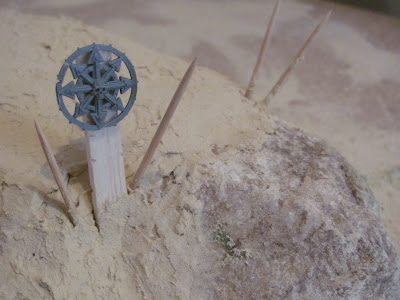Deciding that I was spending too much time idly thinking I went to work about the house, cleaning out the spare room and garage so as to appease the lords of domesticity. Just as I was considering what I was going to make my castle from I came across a couple of boxes with polystyrene liners - remnants of some recently purchased electronic goods. Lining them up next to the recycling bin I decided to take a closer look. After pulling them apart I could see a future in these polystyrene lumps and subsequently saved them for the construction of my new edifice. If you don't have polystyrene suitable for your building/castle/dungeon/giant pants I recommend that you chat with your local electronics store or tech college - they usually have a tonne of this stuff and rarely do they have any use for it.

Before putting the pieces of the castle together there was a bit of work to be done. Each piece had to fit perfectly at a 90 degree angle to the others, so some cutting was required. When cutting polystyrene there are a couple of methods - the most popular being the 'bread knife' and 'hot wire' techniques. I used the former but many swear by hot wire cutters, they tend to be cleaner and very fast (but create a terrible smell). Using a bread knife is slower and you have to be careful not to tear chunks off, it is also a bit messy but it's the cheaper option (assuming you have a serrated/bread knife) and works perfectly well. Before you cut make sure that you've got the angle correct - once cut there is no going back.

NOTE: If using a knife don't push or force it through - use a gentle sawing motion instead, let the serrations do the work. If you're using a hot wire cutter make sure that you're cutting on something not likely to melt/burn easily. For both method make sure you're outside - the hot wire will make a horrible smell and the knife will leave a mess (I cut with a plastic bag beneath the polystyrene as it captures all the waste and makes life much easier).
 Above: All angles correct and ready to put together.
Above: All angles correct and ready to put together.Once all the cutting was done it was time to line up the pieces and see how they fitted together. To do this I used a few double pointed toothpicks, though you could use cocktail sticks, skewers or anything similar. Stick a couple on each surface to be joined and then carefully slide them together. Make sure that you do this BEFORE you add any glue, else you won't be able to change them around/modify them.



Above and Below: If you look closely you'll notice that there are some rough parts inbetween the 'pillars' at the front - the same goes for the pieces of the side. This is where I've used to knife to flatten unwanted protusions off, making the walls look more consistent. I'll be using filler later to smooth these over, give the foam some texture and to ensure that the foam doesn't melt when I undercoat it (more about that in another installment). The small pieces of foam in front are parts that I cut off of the pieces of foam that I didn't want - they're going to help by continuing the line of the half pillars and filling the gap.

Below: The final product. I was excited about how this was going to turn out but now I'm psyched - unpainted and factory white it's looking cool, but once it's rendered, detailed and painted it'll be a different ball game altogether. In keeping with the spirit of how I believe this hobby should be approached there will be as much recycling and as little monetary expenditure as possible, relying instead upon creativity and items we all have lying around (though I am going to scrounge through my parts box for quite a few bits and pieces).

In case you were wondering the back of the castle is not going to be a wall...

The next installment will demonstrate how to base, add detail and get the castle ready for painting.
Cheers!


















































